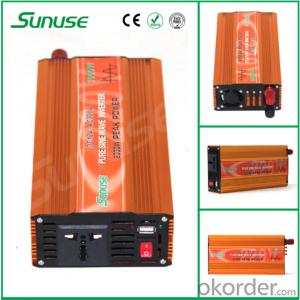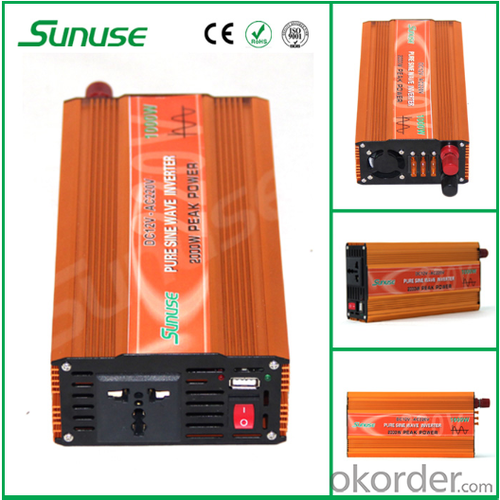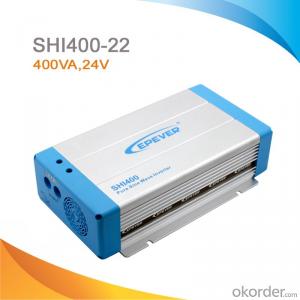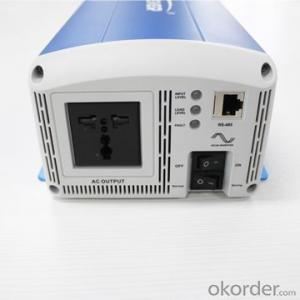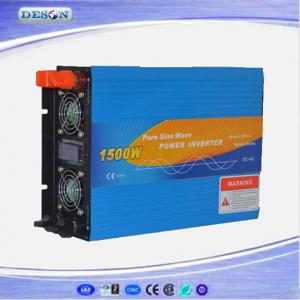Solar Inverter Box:Off Grid 1000W DC 12/24V to AC 110/220V Pure Sine Wave Inverter
- Loading Port:
- Qingdao
- Payment Terms:
- TT OR LC
- Min Order Qty:
- 50000 watt
- Supply Capability:
- 3000000 watt/month
OKorder Service Pledge
OKorder Financial Service
You Might Also Like
1. Structure of Off Grid 1000W DC 12/24V to AC 110/220V Pure Sine Wave Inverter Description
A solar inverter, or PV inverter, or Solar converter, converts the variable direct current (DC) output of a photovoltaic (PV) solar panel into a utility frequency alternating current (AC) that can be fed into a commercial electrical grid or used by a local, off-grid electrical network. It is a critical BOS–component in a photovoltaic system, allowing the use of ordinary AC-powered equipment. Solar inverters have special functions adapted for use with photovoltaic arrays, including maximum power point tracking and anti-islanding protection.
2. Main Features of the Off Grid 1000W DC 12/24V to AC 110/220V Pure Sine Wave Inverter
﹒convert 12V/24V DC to 220V/110V AC to supply for the electronic products such as player MP3, player MP4
﹒DC 12/24V to AC 110/220V
3. Off Grid 1000W DC 12/24V to AC 110/220V Pure Sine Wave Inverter Images
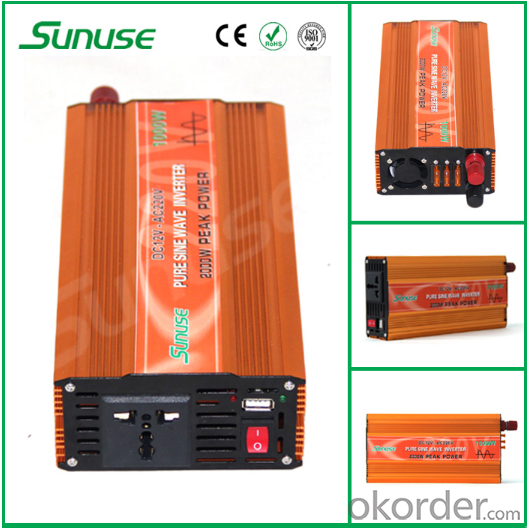

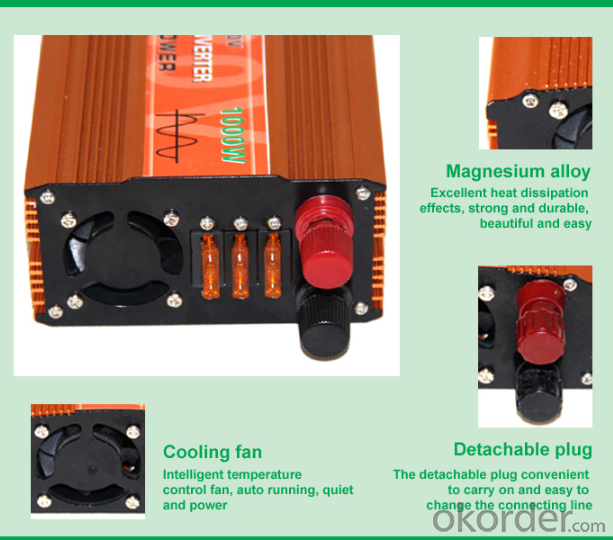
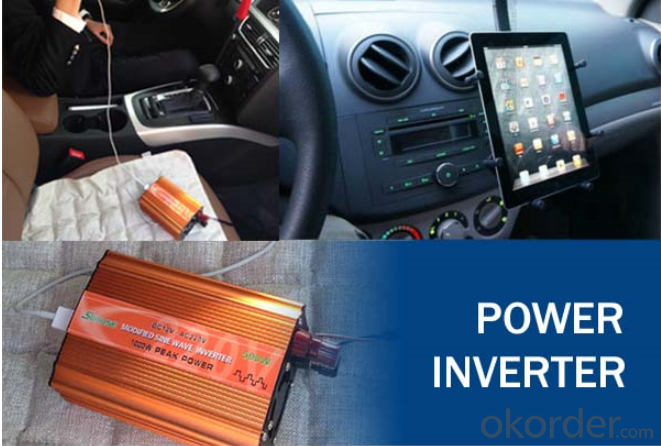
4. Off Grid 1000W DC 12/24V to AC 110/220V Pure Sine Wave Inverter Specification
Specifications: | |||
Type: | 1000W 12V | 1000W 24V | 1000W 48V |
Input DC Voltage Range: | 11-15V DC/22-31V DC/44-62V DC | 11-15V DC/22-31V DC/44-62V DC | 11-15V DC/22-31V DC/44-62V DC |
Under-voltage Protective: | 10.0±0.3V DC/20.0±0.8V DC | 10.0±0.3V DC/20.0±0.8V DC | 10.0±0.3V DC/20.0±0.8V DC |
Under-voltage Alarm: | 10.5±0.3V DC/21.0±0.8V DC | 10.5±0.3V DC/21.0±0.8V DC | 10.5±0.3V DC/21.0±0.8V DC |
Over Voltage Protective: | 16.0±0.3V DC/31.0±0.8V DC | 16.0±0.3V DC/31.0±0.8V DC | 16.0±0.3V DC/31.0±0.8V DC |
Over Voltage Recovery: | 15.0±0.3V DC/29.0±0.8V DC | 15.0±0.3V DC/29.0±0.8V DC | 15.0±0.3V DC/29.0±0.8V DC |
Max Power: | 1000W | ||
Peak Power: | 2000W | ||
USB: | 2000mA | ||
Reverse Protecion: | Blown fuses | ||
Over Load Protection Power: | 110%-120% | ||
Quiescent Current: | ≤0.4A | ||
Max. Efficiency: | ≥92% | ||
Total Harmonic Distortion: | ≤3% Linear load(pure sine wave) | ||
Status Indicator Lamp: | Work: Green LED Failure: Red LED and alarm LED Display: Voltage, Current, Power(optional) | ||
Usage: | for a car, truck, boat, home or standard battery; or solar system, etc. | ||
Work condition: | Operating Temperature: -10~40°C Opetating Humidity: 10--90%(non-condensate) | ||
5. FAQ of Off Grid 1000W DC 12/24V to AC 110/220V Pure Sine Wave Inverter
Q1. What is the difference between inverter and solar inverter?
A1. Inverter only has AC inpput, but solar inverter both connect to AC input and solar panel, it saves more power.
Q2. What is the difference between MPPT&PWM?
A2. MPPT has higher efficiency, it can track the max power point and won't waste energy.
Q3. What is the waranty of product?
A3. 12 months.
- Q: Can a solar inverter be used in areas with unstable power grids?
- Yes, a solar inverter can be used in areas with unstable power grids. Solar inverters are designed to convert the direct current (DC) generated by solar panels into alternating current (AC) for use in homes or buildings. In areas with unstable power grids, solar inverters can help stabilize the electricity supply by synchronizing the solar power output with the grid. Additionally, some advanced solar inverters have features like grid support functions and voltage regulation, which can further enhance their performance in areas with unstable power grids.
- Q: Can a solar inverter be used with battery storage?
- Yes, a solar inverter can be used with battery storage. In fact, integrating a solar inverter with battery storage systems allows for storing excess solar energy generated during the day and using it at night or during times of high energy demand. This combination enables greater energy independence and the ability to use renewable energy even when the sun is not shining.
- Q: How does a solar inverter handle variations in grid frequency?
- A solar inverter handles variations in grid frequency by constantly monitoring the frequency of the grid and adjusting its own output accordingly. It does this through a process called frequency synchronization, where it synchronizes its output frequency with the grid frequency. This allows the solar inverter to seamlessly adapt to any changes in grid frequency, ensuring a stable and reliable power supply to the connected solar panels or the grid.
- Q: Can a solar inverter work without batteries?
- Yes, a solar inverter can work without batteries. Solar inverters are devices that convert the direct current (DC) produced by solar panels into alternating current (AC) which can be used to power household appliances or fed into the electrical grid. While batteries can store excess energy produced by the solar panels, they are not necessary for the basic functioning of a solar inverter. The inverter can directly convert the DC power into AC power for immediate use without the need for energy storage.
- Q: What is the role of a synchronization circuit in a solar inverter?
- The role of a synchronization circuit in a solar inverter is to ensure that the inverter is synchronized with the utility grid. This circuit monitors the frequency and phase of the grid and adjusts the inverter's output accordingly to match the grid's characteristics. By synchronizing the inverter with the grid, it allows for safe and efficient power transfer, prevents disruptions to the grid, and enables the inverter to operate in parallel with other power sources.
- Q: What is the purpose of a solar inverter?
- The purpose of a solar inverter is to convert the direct current (DC) electricity generated by solar panels into alternating current (AC) electricity that can be used to power household appliances and be fed back into the electrical grid.
- Q: What is the role of voltage regulation in a solar inverter?
- The role of voltage regulation in a solar inverter is to ensure that the voltage output from the solar panels is converted and maintained at a stable and appropriate level for efficient and safe operation of electrical devices or for grid connection. This regulation helps to optimize the performance of the solar inverter and prevents voltage fluctuations that could potentially damage or disrupt the functioning of connected equipment.
- Q: Can a solar inverter be used with different types of batteries?
- Yes, a solar inverter can be used with different types of batteries as long as the voltage and current ratings of the batteries are compatible with the inverter's specifications. However, it is important to ensure that the inverter is programmed or configured correctly to work with the specific battery chemistry and charging requirements to optimize performance and prevent any potential damage.
- Q: How do you choose the right brand of solar inverter?
- Choosing the right brand of solar inverter involves considering factors such as reliability, efficiency, warranty, compatibility with your solar system, and customer reviews. Researching and comparing different brands, their track record, and customer feedback can help in making an informed decision. Additionally, consulting with solar professionals or seeking recommendations from reputable sources can further aid in selecting the most suitable brand for your specific needs and budget.
- Q: Can a solar inverter be used in locations with high humidity or extreme temperatures?
- Yes, solar inverters can be used in locations with high humidity or extreme temperatures. However, it is important to choose an inverter specifically designed for such conditions. High-quality inverters are built to withstand these environmental factors and often have protection features to ensure reliable performance and longevity in harsh climates.
Send your message to us
Solar Inverter Box:Off Grid 1000W DC 12/24V to AC 110/220V Pure Sine Wave Inverter
- Loading Port:
- Qingdao
- Payment Terms:
- TT OR LC
- Min Order Qty:
- 50000 watt
- Supply Capability:
- 3000000 watt/month
OKorder Service Pledge
OKorder Financial Service
Similar products
Hot products
Hot Searches
Related keywords
